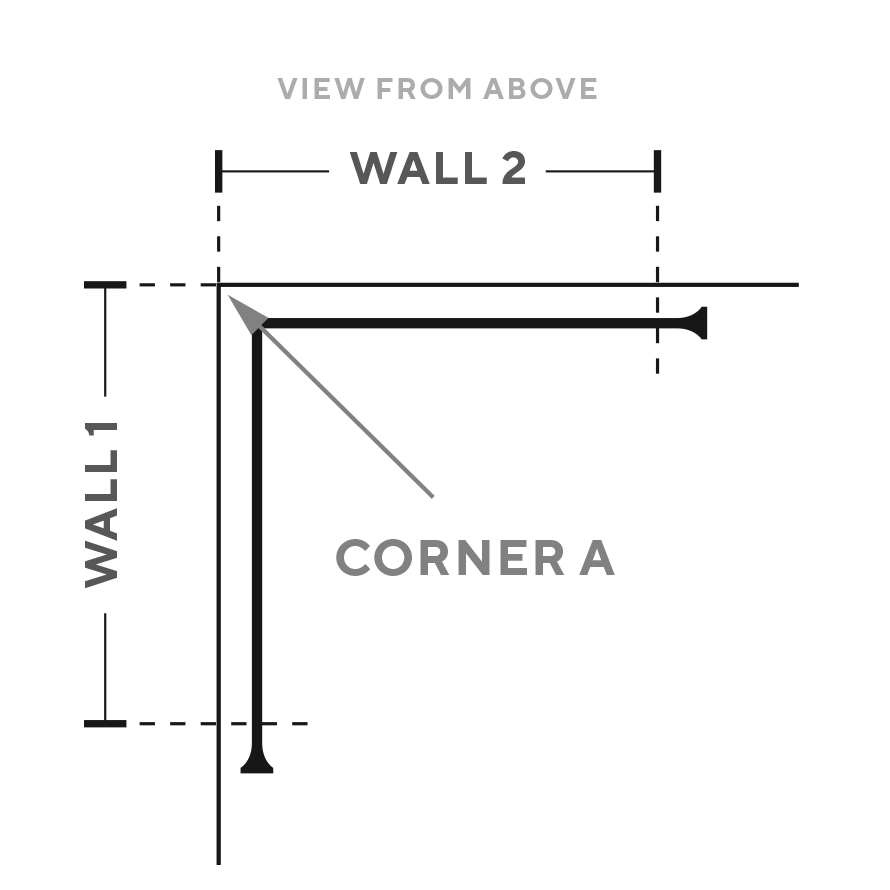
Simply provide us with the wall and corner measurements, and we will calculate the actual size of the rod based on your desired clearance.
We will need to know your desired clearance, as well as these 3 measurements:
1. Wall 1 Length
2. Corner Span Length
3. Wall 2 Length
Wall 1 Length
This is the length from the corner crease of the wall to the point where you'd like the rod to end along Wall 1 (the left-hand side of the corner if viewing from the front). Measure out from the corner to the desired end of the rod, finial NOT included. Be sure to measure in a straight and level line (parallel with the floor) and near the wall.
Wall 2 Length
This is the length from the corner crease of the wall to the point where you'd like the rod to end along Wall 2 (the right-hand side of the corner if viewing from the front). Measure out from the corner to the desired end of the rod, finial NOT included. Be sure to measure in a straight and level line (parallel with the floor) and near the wall.
Please Note: It's important to understand that the Wall 1 and Wall 2 lengths you are providing will not be the actual rod lengths you receive: The actual rod lengths will be a bit shorter, and are determined by the calculations we do based on your clearance and Corner Span Length.
Overhang
Be sure to take into account the overhang on the outer ends of the corner windows. Overhang is the amount the rod extends past the outer edges of the window trim. A certain amount of overhang is useful so that the drapery does not block the window when the curtains are fully opened. We recommend around 4" to 6" on each side for short rods, and up to 6” to 12" for long rods. Aesthetics, drapery use and thickness, and rod length are all considerations in determining overhang.
If using finials
Make sure there will be adequate room at each end of the rod for the additional length of the finials. Please note that the measurement you provide for the length of your walls are for the length of the rod only - NOT including finials. The finials will extend out beyond this length. This is true regardless of type of rod or finial.
If using socket brackets
Typically, sockets are not used with corner rods. However, if your mounting requires it, make sure to subtract 3/8" from the length of any wall measurement which will use a socket to allow room for the bracket itself. For example: If using a socket bracket on each end of your corner rod, subtract 3/8" from the measurement of Wall 1 and 3/8" from the measurement of Wall 2. In fact, we suggest subtracting 1/2" from each end to allow for a bit of wiggle room.
Clearance and French Returns:
So that we can properly size your corner rod, we will need you to specify the desired clearance. Clearance is the distance between the wall and the back of the rod. If you choose French returns for your rod, please click here for more info.
Corner Span Length:
The corner span measuring technique is an easy way to determine the exact angle of the corner, without having to provide us with a template or a measurement in degrees. Of course you can also provide us with the degree measurment by email or phone if you have it.
Find a space along the corner which has no windows or other objects within 24" of the corner crease on either side. Mark this point in the corner crease with a pencil. We'll call this the "corner point".
Next, measure out from the corner point, along the wall to the left of the corner (and keeping parallel to the floor), to a point exactly 24" from the corner point. Mark this point, we'll call it the "left point".
Now, measure out from the corner point again, this time along the wall to the right of the corner (and keeping parallel to the floor), to a point exactly 24" from the corner point. Mark this point, we'll call it the "right point".
Now measure the exact distance between the two outer points marked. This distance between the left point and the right point is the length of the corner span.
It is important to make sure all your marks are on a level plane (and parallel to the floor).
Here are some common corner spans:
- 90° angle = 34" corner span
- 135° angle = 44 3/8" corner span
Don't worry, there is some forgiveness! Each 1/4" of corner span equates to roughly 1 degree of corner angle. Your corners will still work if off by 1 degree.



